Are you a Quiet Speculation member?
If not, now is a perfect time to join up! Our powerful tools, breaking-news analysis, and exclusive Discord channel will make sure you stay up to date and ahead of the curve.
This weekend, the SCG Open Series descends upon the beautiful city of Charlotte, North Carolina. In my unbiased opinion, Charlotte is an incredible city, full of beautiful architecture, delicious food, and generally acceptable people, as far as cities go. I may be a little biased, as I’ve been living near Charlotte for the past 10 years, and while I am by no means “well-traveled”, Magic has taken me to more than a few cities in America, and I can confidently say Charlotte is one of the best. It is fitting, then, that one of the best cities in America will serve host to one of the best formats of Magic – Modern! SCG Charlotte serves as the bridge between the trifecta of high level Modern events of a few months ago (GP’s Charlotte, Copenhagen, and Singapore) and the upcoming World Championships and GP’s Oklahoma City, Brazil, and Pittsburgh later in the year. The environment surrounding SCG Charlotte is ripe for exploitation as Modern has been out of the spotlight since June, yet the Season Two PPTQ circuit has featured Modern, leaving a lot of technology and information available for those willing to dig.
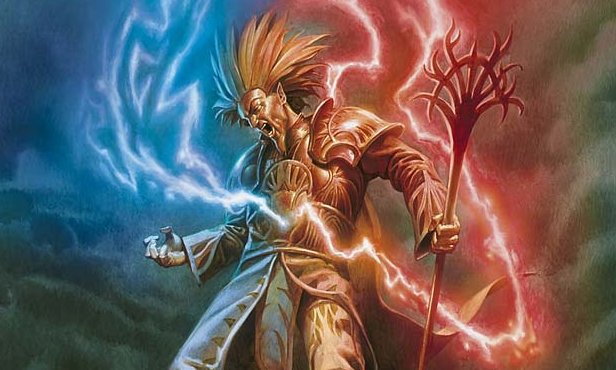
Regular readers of my column and viewers of my Twitch stream will know that I have been piloting Grixis Control in Modern for a few months now. My experience with the deck stretches all the way back to before Grand Prix Charlotte in early June, and I have been tuning and tweaking my list constantly since then for both the MTGO Modern Festival and local PPTQ’s, along with recreational play and small MTGO events. I have logged hundreds of actual matches with the deck and have played with multiple permutations through various metagames/levels of hate, so I figured it would be a good idea to do a primer on the archetype for anyone looking to play either at Charlotte, or with the deck in the future. Let’s get to it!
[wp_ad_camp_1]
Grixis Control Basics
Grixis Control is at heart an aggro-control strategy, focused on extracting value in the midgame and turning the corner when necessary. While capable of both fast starts and long grinds, Grixis Control functions best as a midrange strategy, similar (but not exactly) to strategies like Abzan and Jund. Where archetypes like Abzan and Jund work to grind their opponent down with resilient threats, discard and better lategame topdecks, Grixis plays slightly slower, valuing card quality early and relying on card advantage to pull ahead in the midgame.
Grixis Control, by Trevor Holmes
Grixis contains unique elements of card advantage, ramp, permission, graveyard synergies, direct damage, and inevitability, and as a result can be built in innumerable ways to minimize or maximize specific interactions. First, we’ll outline the core of the deck, and then talk about ways that it can be adapted. I’ll be using my own list for sideboarding as shown above, but usually the concept remains the same regardless of specific card choices.
Eight one-drop cantrips
A full playset of Serum Visions and Thought Scour make up the foundation of almost every blue deck in Modern. Serum Visions exists as the “best of the rest” after the banning of Ponder and Preordain and allows us to cantrip while manipulating the top of our deck for future draws. Thought Scour is widely considered second-best to Visions, but the mill two ability is pushed to the limit in our deck, improving our numerous graveyard synergies.
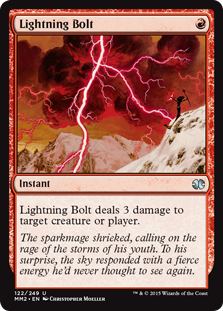 Four Snapcaster Mage, four Lightning Bolt
Four Snapcaster Mage, four Lightning Bolt
By no means uncuttable sacred cows, the cheap, aggressive nature of Modern along with the prevalence of mana creatures has made Lightning Bolt, and Snapcaster Mage to flash back Lightning Bolt, a mainstay of the format for quite a while now. I could write a whole article on why these cards are good, but I won’t. Some metagames have made playing three copies of either of these acceptable at best, but these occasions are rare and normally the result of a format shifted way off base.
4-5 delve creatures
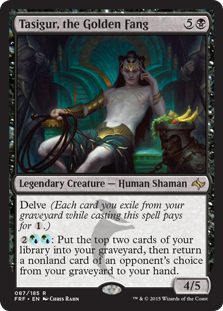 Grixis Control exists because Tasigur, the Golden Fang and Gurmag Angler are excellent in the format. Alongside cheap interaction, fetchlands and Thought Scour, delve as a mechanic has proven its worth in Modern, and the opportunity cost of playing large, powerful creatures that use the graveyard as a resource is relatively low. While usually interchangeable, the delve pair each have their own strengths and weaknesses, which can account for shifts in specific numbers depending on a few factors. Tasigur, the Golden Fang is best in grindy formats and excels in matchups like Twin and Scapeshift, but is worse against Tarmogoyf or when a quick clock is needed. Gurmag Angler is better for racing (5/5 compared to the 4/5) and for attacking into/holding off Tarmogoyf, which is usually a 4/5 on most boards.
Grixis Control exists because Tasigur, the Golden Fang and Gurmag Angler are excellent in the format. Alongside cheap interaction, fetchlands and Thought Scour, delve as a mechanic has proven its worth in Modern, and the opportunity cost of playing large, powerful creatures that use the graveyard as a resource is relatively low. While usually interchangeable, the delve pair each have their own strengths and weaknesses, which can account for shifts in specific numbers depending on a few factors. Tasigur, the Golden Fang is best in grindy formats and excels in matchups like Twin and Scapeshift, but is worse against Tarmogoyf or when a quick clock is needed. Gurmag Angler is better for racing (5/5 compared to the 4/5) and for attacking into/holding off Tarmogoyf, which is usually a 4/5 on most boards.
A 2-2 split between Tasigur/Angler is normal, though some lists play the third Gurmag Angler over the second Tasigur. Rarely do lists play a 3-1 split in favor of Tasigur; partly because of the legendary rule, but mostly because of the prevalence of Tarmogoyf in the format. The legendary drawback is not as relevant as you would think, usually we only have one delve creature on the field at a time as they are expensive to play and a big target for opposing removal. If the format shifted to feature a lot of blue decks and permission and less Tarmogoyf, a 3-1 split in favor of Tasigur is perfectly acceptable.
3-4 Terminate, 4-5 value three drops
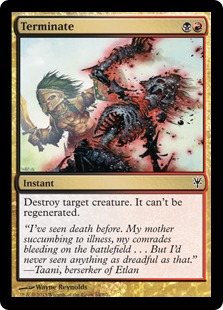 Terminate exists as a solid unconditional two drop removal spell that kills everything, unlike Lightning Bolt. One-drops, Tarmogoyf, artifact creatures, and Deceiver Exarch all fall victim to Terminate, and while the no-regen clause rarely comes up, it is relevant against Welding Jar in the Affinity matchup. Combo prevalent metagames could cause us to want to play only three, as it is poor against Living End, Amulet Bloom, Grishoalbrand, Scapeshift and Tron, but it does good enough work against Affinity, Twin, Jund, Merfolk, Infect, Burn and every other deck that plays fair creatures that is has earned it’s 3-4 slots. Most Grixis lists have room for 4-5 slots for value three drops, usually three Kolaghan's Command and an Electrolyze. Kolaghan's Command, along with Snapcaster Mage and delve creatures is the reason to play Grixis in Modern, giving us an excellent way to compete with discard while also going late against control, disrupting combo opponent’s hands, two-for-oneing small creature decks, and shoring up the Burn and Affinity matchups. Electrolyze exists to fight Lingering Souls, which is this deck’s weakness, but it also does solid work against creatures and is never dead.
Terminate exists as a solid unconditional two drop removal spell that kills everything, unlike Lightning Bolt. One-drops, Tarmogoyf, artifact creatures, and Deceiver Exarch all fall victim to Terminate, and while the no-regen clause rarely comes up, it is relevant against Welding Jar in the Affinity matchup. Combo prevalent metagames could cause us to want to play only three, as it is poor against Living End, Amulet Bloom, Grishoalbrand, Scapeshift and Tron, but it does good enough work against Affinity, Twin, Jund, Merfolk, Infect, Burn and every other deck that plays fair creatures that is has earned it’s 3-4 slots. Most Grixis lists have room for 4-5 slots for value three drops, usually three Kolaghan's Command and an Electrolyze. Kolaghan's Command, along with Snapcaster Mage and delve creatures is the reason to play Grixis in Modern, giving us an excellent way to compete with discard while also going late against control, disrupting combo opponent’s hands, two-for-oneing small creature decks, and shoring up the Burn and Affinity matchups. Electrolyze exists to fight Lingering Souls, which is this deck’s weakness, but it also does solid work against creatures and is never dead.
2-3 Cryptic Command, 5-7 counterspells
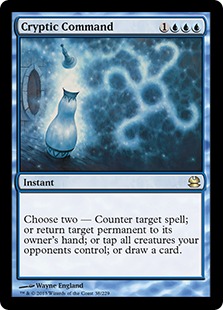 Kolaghan's Command asks us to push our curve up a little higher, as we often want to Snapcaster Mage/Kolaghan's Command in the midgame, which requires five or six land on the field. This makes us play a slightly larger land count than the Delver decks (22 land vs. 18/19), which in turn lets us afford to play Cryptic Command and reliably get to the mana required to cast it (with Spell Snare or Dispel protection, hopefully). The king of Modern counterspells, Cryptic Command is clunky, but if we can successfully cast it the payoff is big. I’ve played around with the numbers and feel like two is the right number for my playstyle, as I usually like to cast one in a game, but two in hand can be very clunky, especially alongside our Delve creatures. The other counterspells can be a mix of Spell Snare, Mana Leak, Remand, and Deprive, with Dispel tagging in occasionally, or Vendilion Clique as a pseudo-counterspell that forms
Kolaghan's Command asks us to push our curve up a little higher, as we often want to Snapcaster Mage/Kolaghan's Command in the midgame, which requires five or six land on the field. This makes us play a slightly larger land count than the Delver decks (22 land vs. 18/19), which in turn lets us afford to play Cryptic Command and reliably get to the mana required to cast it (with Spell Snare or Dispel protection, hopefully). The king of Modern counterspells, Cryptic Command is clunky, but if we can successfully cast it the payoff is big. I’ve played around with the numbers and feel like two is the right number for my playstyle, as I usually like to cast one in a game, but two in hand can be very clunky, especially alongside our Delve creatures. The other counterspells can be a mix of Spell Snare, Mana Leak, Remand, and Deprive, with Dispel tagging in occasionally, or Vendilion Clique as a pseudo-counterspell that forms  the bridge between Mana Leak and Cryptic Command.
the bridge between Mana Leak and Cryptic Command.
Tempo heavy metagames ask for more Remand and less Deprive, while grindier games work best for Deprive as an actual "Counterspell" going late, where the drawback isn’t that painful. Spell Snare is excellent, but I wouldn’t play more than two, as it can sometimes be awkward and difficult to cast successfully if our opponent is consciously trying to play around it. Remand is a sweet one-of that works best in tempo and combo strategies, but we can take advantage of it here by just buying some time, or Remanding our own spells against other blue decks.
The mana base
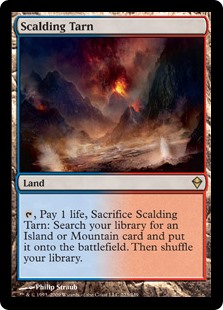 Most Grixis Control lists play 22 lands, with some controlling versions that play more Cryptic adding a 23rd, while some leaner builds occasionally play 21. Normally Grixis plays eight fetchlands, (three Scalding Tarn, four Polluted Delta, one Bloodstained Mire) with Delta getting the 4th copy as our optimal land sequencing against aggressive decks is Steam Vents into Swamp. The prevalence of Blood Moon in the format means we are much more likely to fetch basic Swamp over basic Mountain as well. While Moon isn’t necessarily good against us (and we can play it ourselves if we wish) it is still important to not lose to it, so always keep that in mind. Most lists play two copies each of Vents and Grave, with Sulfur Falls as another dual that can untap under Choke along with Creeping Tar Pit.
Most Grixis Control lists play 22 lands, with some controlling versions that play more Cryptic adding a 23rd, while some leaner builds occasionally play 21. Normally Grixis plays eight fetchlands, (three Scalding Tarn, four Polluted Delta, one Bloodstained Mire) with Delta getting the 4th copy as our optimal land sequencing against aggressive decks is Steam Vents into Swamp. The prevalence of Blood Moon in the format means we are much more likely to fetch basic Swamp over basic Mountain as well. While Moon isn’t necessarily good against us (and we can play it ourselves if we wish) it is still important to not lose to it, so always keep that in mind. Most lists play two copies each of Vents and Grave, with Sulfur Falls as another dual that can untap under Choke along with Creeping Tar Pit.
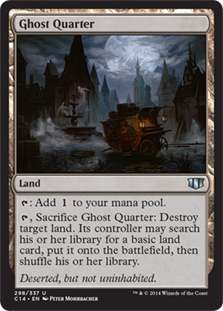 Blood Crypt is present in lots of lists, but I have long since cut it from mine, as it’s a dual that we rarely want to fetch and is horrible in opening hands alongside Serum Visions and Thought Scour. Two-land hands like Island/fetchland are the only hands where Blood Crypt helps us, but we can just fetch Vents and look for a third land that is either a fetchland or Creeping Tar Pit later on. More than “we don’t really want to fetch it”, cutting Blood Crypt means we can afford to play another non-blue land, with the best two options being either Desolate Lighthouse or Ghost Quarter. Currently I’ve been playing Quarter, as it is excellent against Amulet Bloom and Tron, does good work against Affinity lands, and can even fix our mana in a pinch.
Blood Crypt is present in lots of lists, but I have long since cut it from mine, as it’s a dual that we rarely want to fetch and is horrible in opening hands alongside Serum Visions and Thought Scour. Two-land hands like Island/fetchland are the only hands where Blood Crypt helps us, but we can just fetch Vents and look for a third land that is either a fetchland or Creeping Tar Pit later on. More than “we don’t really want to fetch it”, cutting Blood Crypt means we can afford to play another non-blue land, with the best two options being either Desolate Lighthouse or Ghost Quarter. Currently I’ve been playing Quarter, as it is excellent against Amulet Bloom and Tron, does good work against Affinity lands, and can even fix our mana in a pinch.
Grixis Control Matchups
Before going into sideboarding options, I want to give an overview of how our deck matchups up against most of the top decks in the format, and how we should play against each strategy. Unlike one dimensional archetypes such as Burn (which is always the aggressor) and Jeskai (which is always control) we have the ability to play either re-actively or proactively, and our role can change depending on matchup, play vs. draw, how we sideboard and what our opening seven looks like.
Twin
Splinter Twin strategies can come in many colors, be it UR, Grixis, or Temur. Based on results (and my own opinion) Grixis Twin seems to be the best of the three currently, so that is the matchup that we will focus on primarily. Borrowing from the success of Grixis Control, Grixis Twin looks to incorporate the Kolaghan's Command/Tasigur, the Golden Fang package into their list to present another angle of attack. While they are primarily a combo-control strategy, Twin is used to winning through alternative means, and Tasigur bolsters the otherwise anemic Deceiver Exarch/Pestermite/Snapcaster Mage-beats that Twin is sometimes forced to use to win the game. Games 1’s against this deck are normally pretty grindy; Twin can’t usually risk attempting to combo out quickly as we have four Terminate plus a few Mana Leaks to stop a quick kill. If they don’t go for a quick kill, the classic control sub-game initiates, where both players attempt to make land drops and pull ahead on resources, both in hand and on the table.
Playing 22 lands lets us keep up with Twin regarding land development, and our lategame is better than theirs with Creeping Tar Pit and Cryptic Command. In addition, Tasigur and Gurmag Angler are both serious threats if they land, as Grixis Twin only has access to a few Terminates (if any) and UR and Temur are reduced to either Roasting it or getting tricky with Lightning Bolt and Snapcaster. It seems a little unintuitive, as they are the combo deck, but often Grixis Twin is more worried about how to answer Gurmag Angler, and then Kolaghan's Command returning Angler, than we are worried about them putting a Twin on an Exarch. Their combo is clunky and expensive, while we get to do cool things like dropping an early Snapcaster just so it can die, so we can fire off a quick Kolaghan's Command to put it in the graveyard to Snapcaster it back later on.
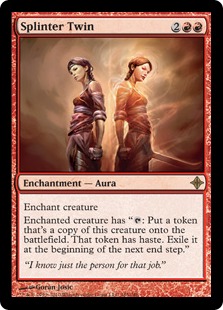
OUT
-2 Mana Leak
-1 Electrolyze
-1 Gurmag Angler
-1 Lightning Bolt
IN
+1 Bitterblossom
+3 Dispel
+1 Fulminator Mage
Sideboarding in this matchup is tricky and varies wildly depending on our gameplan, their gameplan, and whether they are keeping in the combo or taking it out. How they board influences whether we want four Fulminator Mage, or none of them. Duress could be great, or horrible, depending on their trump of choice. On their side, they are incentivized to take out the combo, as it is hard for them to fight through our four Terminates when we are also bringing in Dispels to supplement our Spell Snares to protect our removal. They are constantly in this position where they have to devote more mana to their combo than we have to devote to answering it, putting us at an advantage in the exchange, and putting the pressure on them to be ahead both on board and on mana. This is difficult for them to do, as their hand can be clogged with combo pieces and protection, as well as Bolts and other removal that they can’t take out, otherwise they die to our attackers (which we can slip in for one mana at any time). If they take out the combo, they are basically just a bad Grixis Control deck. They get huge trumps in Keranos, God of Storms and Teferi, Mage of Zhalfir that they might be able to sneak in and steal a win, but when it comes down to it they are boarding into a control deck as their Plan B, while we showed up to the table with control as our Plan A, so we should be favored as long as nothing crazy happens.
Delver
There was a time when Delver players tried to cut their Delvers after board in an attempt to go bigger. This was done because we had numerous ways to answer their Delvers between Bolt, Terminate, and Kolaghan's Command, but they couldn’t compete with us in a longer game as the Delver decks only played 18 land and weird tempo spells like Gitaxian Probe, and we could just out-grind them. Now, the Delver decks have wised up, keeping in Delver of Secrets and Mana Leaks in an attempt to kill us before we can take over with Kolaghan's Command value. This has turned what was once an easy matchup into one of our worst, as we have to scramble to fight through their early rush and protection while hoping not to die to our own clunky draws. You know things are bad when you catch yourself wishing for a Gut Shot just to stop the bleeding.
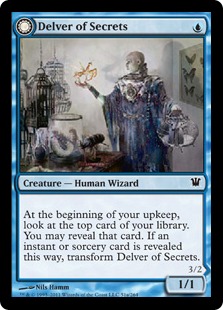
OUT
-1 Gurmag Angler
-1 Remand
-2 Cryptic Command
-1 Thought Scour
-2 Jace, Vryn's Prodigy
IN
+1 Izzet Staticaster
+3 Dispel
+1 Engineered Explosives
+1 Anger of the Gods
+1 Duress
If we can kill their Delvers, and either keep Young Pyromancer off the field or clean up after it hits, we should have no problems winning the match. Everything that says kill a creature is great, and Duress is in as a one-mana play that either nabs a counterspell or trades with a Spell Pierce or something. Bitterblossom is normally a huge trump in blue matchups, but we can’t afford the life loss as we normally stabilize at a low life total against Delver. Cryptic Command is also just too clunky and unnecessary, and a hand with two delve creatures is usually game over. I would definitely consider Delver to be favored here, and I have thought about having access to a Slaughter Pact in the list to help this matchup primarily (though Gut Shot might be better, as killing a Delver on the draw on their turn five is normally too slow).
Affinity
A pure exercise in mana efficiency, the Affinity matchup can be very swingy, with Kolaghan's Command dominating or us dying in spectacular fashion to a million creatures or a gigantic Etched Champion. The matchup normally comes down to us racing their manlands, and spells should be thrown into the graveyard with vigor to ensure we can power out our delve creatures as early as turn three if possible.
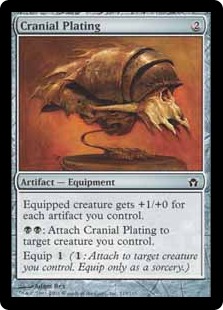
OUT
-2 Cryptic Command
-1 Remand
-2 Jace, Vryn's Prodigy
-1 Serum Visions
-1 Tasigur, the Golden Fang
-1 Thought Scour
IN
+1 Damnation
+1 Bitterblossom
+1 Izzet Staticaster
+1 Vandalblast
+1 Anger of the Gods
+1 Engineered Explosives
+2 Fulminator Mage
Jace, Vryn's Prodigy can be brought back in on the play, but we really can’t afford to play him while we have a counterspell in hand, as it is essential that we don’t let Etched Champion hit the field. Fulminator Mage is great for racing their manlands, which are often the only things left over once we’ve stabilized after a sweeper. If we see Spell Pierce, I normally bring the four delve creature back in, as we are probably going to be forced into racing more often. The matchup can simultaneously seem unwinnable and a cakewalk, depending on how our draw lines up to theirs.
Jund
The Grixis Control vs. Jund matchup seems favorable for Grixis, but can shift wildly the other way depending on how hateful Jund chooses to be. They can tool their sideboards to wreck us with Choke and Leyline of the Void, but we have trumps of our own as well. Jund’s strategy is the same as its always been: rip apart our hand and drop the best thing they can at every spot on the curve, trading resources until they run us out of cards and topdeck better with splashy effects and manlands in the lategame. Gurmag Angler is a huge problem for them, however, forcing them to find a Terminate or Liliana of the Veil or abandon attacking completely. More than any reactive deck in the format, our strategy is resilient to discard due to the value triangle that is delve creature/Kolaghan's Command/Snapcaster Mage. Rather than trying to answer every threat they play, normally just landing and protecting Angler is good enough to buy us some time until they start flooding out (due to their 25 land manabase) and we can draw into our Cryptic Commands and start chaining spells with Snapcaster.
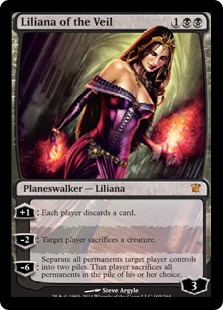
OUT
-2 Mana Leak
-1 Remand
-1 Thought Scour
IN
+1 Damnation
+1 Bitterblossom
+1 Duress
+1 Engineered Explosives
Sideboarding can change depending on whether we have seen Leyline of the Void, or even Maelstrom Pulse in large numbers. Jace, Vryn's Prodigy can be great, letting us ignore a Tarmogoyf for a turn or two, or even just as Liliana of the Veil protection for our Gurmag Angler. He doesn’t need to do much to pay for his two mana investment, and he helps us keep up with their best draws while saving us from our worst. After board, not much changes, we just have to be careful of Choke, and if our opponent is fetching all basics to play around Blood Moon. We might consider bringing in Fulminator Mage as another creature we can sac to Liliana, and a solid answer to their manlands with the upside of color-screwing them.
Merfolk
The bane of blue decks since pretty much forever, Merfolk is a difficult matchup for Grixis Control, but not unwinnable. Their million lords alongside cheap protection and Kira, Great Glass-Spinner can be tough to fight through, especially because we cannot rely on Gurmag Angler as a blocker against their islandwalk. This means we are usually forced to race, which plays right into their Vapor Snag plan. The matchup is better for us on the play, as nabbing an Aether Vial plus something else with Kolaghan's Command can put us pretty far ahead going into the midgame and buy us some time to set up a reasonable defense.
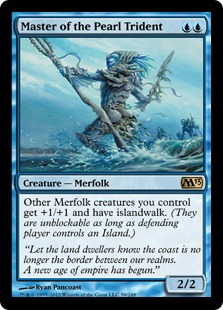
OUT
-2 Cryptic Command
-2 Mana Leak
-1 Remand
IN
+1 Engineered Explosives
+1 Damnation
+1 Anger of the Gods
+1 Dispel
+1 Izzet Staticaster / +1 Dispel
If they are not bringing in Spell Pierces, choosing instead to keep in Vapor Snags for Angler, I will usually bring the Cryptic Commands back in, in place of an Angler and a Jace. Jace is great in this matchup, as he gives us a way to shrink opposing creatures that we cannot block, and getting double use out of a Terminate helps a lot with the creature/removal grind. The matchup is rough, however, and we rely on our sweepers (Engineered Explosives, Anger of the Gods, and Damnation) to get us a two or three-for-one and pull ahead. Don’t forget that Fulminator Mage can destroy Mutavault/Cavern of Souls and can be brought in to replace some Thought Scour and another delve creature.
Burn
Burn is another matchup that was originally horrible, but is now back to about 50/50 I think. Dispel is excellent against them, as is Duress/Kolaghan's Command, and the matchup is an excellent exercise in the classic principle of trading cards for life. Eventually, they will draw their fourth and fifth land, and we can race them with our delve creatures. Recently, some Burn lists have adopted Wild Nacatl as an extra “large” creature to swing with (in an attempt to combat Feed the Clan I believe), but this plays right into our plan of dropping an Angler and locking up the ground.
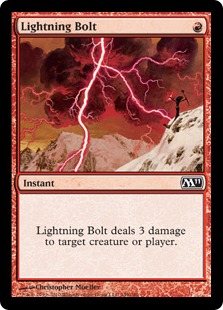
OUT
-2 Cryptic Command
-2 Jace, Vryn's Prodigy
-1 Remand
IN
+1 Duress
+3 Dispel
+1 Anger of the Gods
Their best card against us is Eidolon of the Great Revel, and as long as we can keep that off the field and dodge the sorcery speed part of their Burn we should be fine. (On the other side of the matchup, Burn should be playing its instants early and often, saving Lava Spikes and Rift Bolts for later in the game)
Conclusion
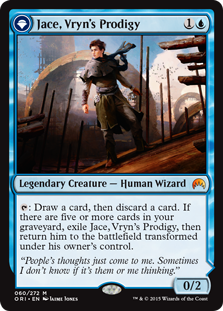 Grixis Control is, as always, a fun, adaptable strategy that has game against every deck in the format (except perhaps Bogles). It can be adapted to beat anything, and lots of sweet tech for the deck exists for those willing to look. Don’t be afraid to try out Deprive, Rise // Fall, Desperate Ravings, Mulldrifter, Grave Titan, Vampiric Link, Bitterblossom, Glen Elendra Archmage, Jace, Vryn's Prodigy, or any of the other cool angles of attack that people have tried. Grixis Control has room in the maindeck for a few flex spots, and is well suited to both find and cast spicy spells, so get to exploring!
Grixis Control is, as always, a fun, adaptable strategy that has game against every deck in the format (except perhaps Bogles). It can be adapted to beat anything, and lots of sweet tech for the deck exists for those willing to look. Don’t be afraid to try out Deprive, Rise // Fall, Desperate Ravings, Mulldrifter, Grave Titan, Vampiric Link, Bitterblossom, Glen Elendra Archmage, Jace, Vryn's Prodigy, or any of the other cool angles of attack that people have tried. Grixis Control has room in the maindeck for a few flex spots, and is well suited to both find and cast spicy spells, so get to exploring!
If you have any questions or comments feel free to let me know in the comments below. I know I didn’t cover every matchup in Modern, but the cool thing about Grixis is that it normally doesn’t matter anyways. The best laid plans of mice and men don’t mean anything when you draw an opener with nothing but Thought Scours and Gurmag Anglers. Get to swingin’!
I’ll be taking the above list to SCG Charlotte and (hopefully) proving Jace, Vryn's Prodigy’s strength to the world. If you’re interested in learning more about the deck, feel free to check out my other articles on Modern Nexus detailing the evolution of the archetype, or just stop by my Twitch stream and ask me some questions! See you there!
-Trevor Holmes
Twitch.tv/Architect_Gaming
The_Architect on MTGO
Twitter.com/7he4rchitect




I like the Vandalblast addition in the sideboard. I’ll be thinking about its inclusion. Thanks for looking at all the cards and their explanation.
Very nice primer. I’m wondering whether Vandalblast will come in early enough to fulfill its blowout potential against Affinity, though. How often do you make it long enough to hit the Overload?
I’m also a fan of having targeted discard in the sideboard, but I’m having a tough time deciding between Duress, Inquisition of Kozilek, or Thoughtseize. You obviously chose Duress, but I’m wondering what the thought process behind it was.
Last but not least, good luck at the SCG! Hopefully you can get some good data on Jace to show us.
I chose Duress to have the most freedom regarding card choice without the life loss from Thoughtseize. Inquisition of Kozilek is great, but I’d like to be able to hit expensive planeswalkers from Tron, Cryptic Command’s, Splinter Twin’s, and Scapeshift primarily. The noncreature drawback isn’t often relevant, as Grixis Control has the best creature removal in the format, and the ability to bring in a discard spell against Burn lets our Duress function as a Healing Salve (which is perfectly fine in the matchup)
Vandalblast gives us options: Most of the time I’m casting it and flashing it back with Snapcaster. If I ever overload it, the game is pretty much over. It’s a great card that I like over Shatterstorm as it can be played both early and late.
Thoughtseize, mostly to board it in against the mirror match. Gotta discard those fatties.
Remand was my latest addition for the mirror, as it’s excellent against Delve. I rarely devote multiple slots to the mirror, I just rely on practice and a trump or two if I can use them elsewhere to bump my opponent off his lane. Still like Duress the best but could change depending on the metagame
Great stuff, Trevor.
I’d love to hear your thoughts on the merits of Sultai or Esper vs. Grixis? Obviously red brings bolt, terminate, and K-command (admittedly, that seems like evidence enough to add the red), but I’m curious about your thoughts of replacing those with abrupt decay, tarmogoyf, path to exile, lingering souls, etcetera. What do you think the benefits / advantages you might gain from using Green or White instead?
I hesitate to give a quick answer as I don’t have much experience with what these archetypes can offer, but I will say that the loss of Lightning Bolt/Terminate/Kolaghan’s Command would have to be made up for in a big way to convince me to switch. Kolaghan’s Command and the power of Gurmag Angler in the format is in my opinion the single reason why Grixis Control is a Tier 1 powerhouse, and pairing that package with Snapcaster Mage, Thought Scour and card draw makes it even better.
Perhaps the metagame shifts to a point where all we want to be doing is casting fatties every turn of the game, at which point Thought Scour into Tarmogoyf into Angler might be awesome. Would love to see some lists!
As someone who has experience with Esper Midrange (Mentorless build), some thoughts:
Mentor is in the current format a bad choice. Either the opposing decks can “ignore” him (aka Combo and Aggro) or have access to Bolt (rest). He was great after the bannings, because of Junk and Infect, where he really shines. We (a friend of mine and myself) replaced him with more Delve creatures and 2 Plainswalker (same amount of threats, 5 Delve creatures and 2 Walkers).
The list is a lot better now and it feels like the Jund/Junk comparison. Esper has access to Lingering Souls and Sorin, Lord of Innistrad (which is an awesome card in this deck), whereas Grixis has K. Command and Bolt. Grixis has a better match-up against non-fair decks, and Esper has a better match-up against all other decks (main reason is Souls).
Some match-ups for non Mentor Esper Midrange:
Good: Midrang (Grixis, Jund)
Decent: Junk (Siege Rhino is a pain), Twin
Even: Affinity (Souls is great here and 10 removal spells help too), most Aggro decks
Bad: Burn (you need Sorin/Vault here, and/or an early Delve creature)
Nearly unwinnable: Tron
Greetings,
Kathal
Having played sultai delver, I can say that in general the gain of goyf+decay is not worth the loss of bolt+command+terminate. The sultai version can struggle versus an early opposing threat backed up by a path to exile.
I am not sure how these grixis decks beat a t0 leyline of the void though. Practically all of the decks value is derived from the graveyard – delve, snap, scour, command.
Hey love wqtching the stream AMD readig the articles, keep up the good work, and keep playing the best format
Thanks! Go Modern!
What is your matchup against a Mentor deck. I know how I fare against Grixis Control, but what is your take on it? To phrase the question better – “If you assume I have a really good way to make sure Lightning Bolt is a non-factor, how does your removal fair against the mirror match if your commands and electrolyze are a point of damage short?”
Monastery Mentor is an extremely powerful card, as long as the Mentor deck can shift the game to the point where it is good. The downside to Monastery Mentor has always been it’s 2W casting cost and weakness to Lightning Bolt on the turn it’s cast, but you know that. The point I’m trying to make is that as the Grixis Control player, I try and focus the game to a point where I’m minimizing the amount of damage Mentor can do once it hits the field. Gurmag Angler can be a solid roadblock, but is easily overwhelmed if Mentor is allowed to go crazy. Similar to Lingering Souls, Grixis is weak to multiple “free” creatures, which means I rely heavily on sideboard options like Anger of the Gods and Izzet Staticaster to stay in the fight.
As a side note, I have always been a fan of Esper Mentor’s ability to be the best Slaughter Pact deck. That card should see more play.
That’s a fair assessment of the situation. But the power of assumption strikes again – nowhere did I mention anything about Esper or what colours the deck is in.
He’s trying to be helpful dude, don’t be combative.
Combative is what Nickolay Krumov does, for whatever reason.
That said, I think it was unnecessary – Trevor described facing up against Mentor in the general sense, and only mentioned the Esper Mentor deck as a side note.
Thanks for a great primer and keep up the good work!
What’s your opinion on a more proactive shell with 4 jace and 4-6 discard spells? Jace is better suited with proactive spells than countermagic and curves out nicely with a turn one Inqusition or thoughtseize. This would require the mana base to be changed with darkslick shores/blackcleave cliffs in order to spare some pain on turn one. Then beeing able to recast discards spells through out the game seems tempting.
Iv’e been toying twith this idea since casting jace on turn two wich i generelly want to do if i draw him, often seems wrong when also wanting to hold up countermagic/removal. Discards also brings perfect information of our opponents hands wich is never wrong.
Very instructive article on the grixis control, loved the breakdown you made and sideboard analyses.
Good work!
I think Michael Majors is showing us how to abuse Jace, forget about playing counterspells and just play a black based control deck.
It’s definitely better in a shell that doesn’t mind casting its spells at sorcery speed.
Not completely sold, but the deck is performing at the open.
Michael did great with the deck and I was able to watch him play multiple matches. Will definitely be talking about this in next weeks’ article!
hi, nice article!
what do you think about playing a Darkblast instead of the fourth Thought Scour (in the mainboard)
I think Thought Scour (or Black Lotus, you choose) is uncuttable, but I could see trimming the Electrolyze for it. I wouldn’t mind another dredge effect. 🙂
Why is this called control when it plays more like a midrange deck /shrug
I play this deck, and honestly it feels like draw-go to me.
I essentially never tap out on my turn, ever. Everything is an instant and the only threats you play you usually cast for 1-2 mana with mana left open on your opponent’s turn.
How is this not a control deck? It plays counterspells, removal and card draw.
Don’t you know? Grixis Control is a Midrange deck because it doesn’t only run one wincon. There are FOUR Delve creatures and TWO manlands that can be used to end the game.
And sometimes, it gets that creature down on turn TWO!!! And then it proceeds to use said creature to ATTACK and sometimes win the game. It then has time to play a second and even a THIRD game if required.
It is clear that the only true control deck is UWx and wins with Celestial Colonnade. Anything else is definitely NOT control because we define control in the narrowest sense possible.
(In case it wasn’t apparent, this post is full of sarcasm).
I feel like Rakdos Charm is too awesome to not have one of in the board. A lot of flexibility in the meta (imo)
Hey, could you tag this as “primers” instead of “primer”? Not having them all in one place is annoying.
I actually play 2 Cryptics as well in my list. Most people would argue to play 4 like Patrick Capin does, but it can be argued that 4 is too clunky like you said. I think it eventually comes down to surviving an early game beatdown against most decks, as the current meta is dominated by fast, crazy Aggro decks, that win on turn 4 or 5.
Maybe I will think about playing 4 when the current meta switches to a more Control dominated theme or even Combo.
Thanks for posting this article.